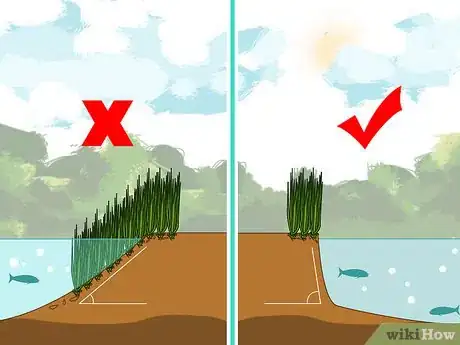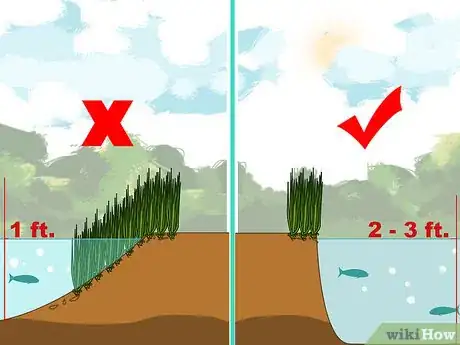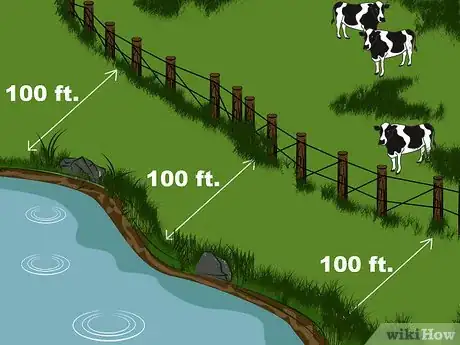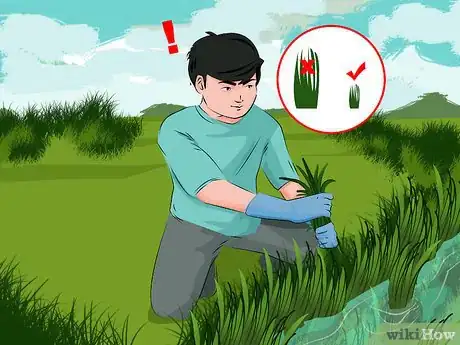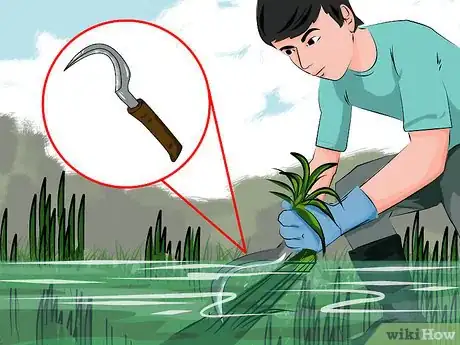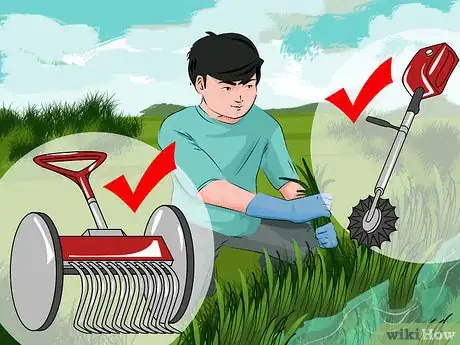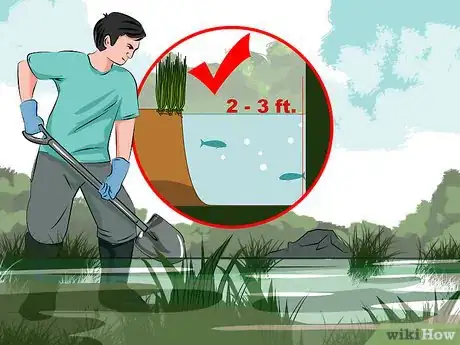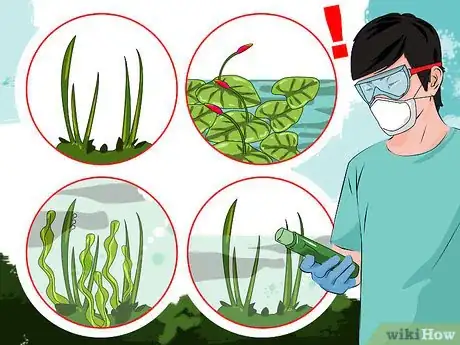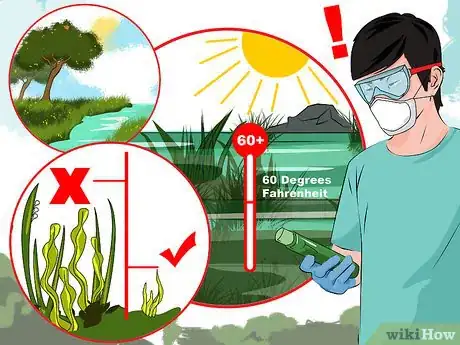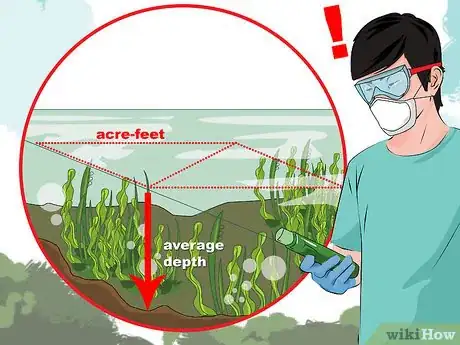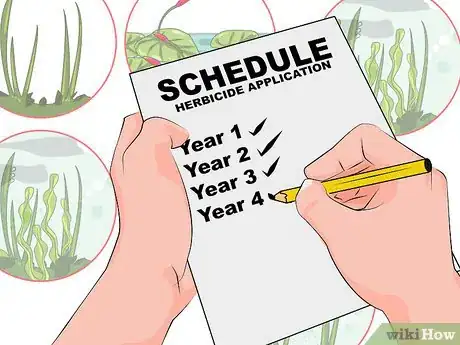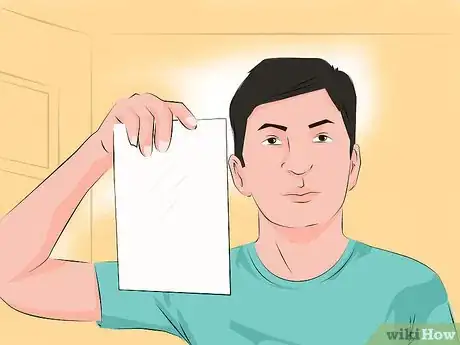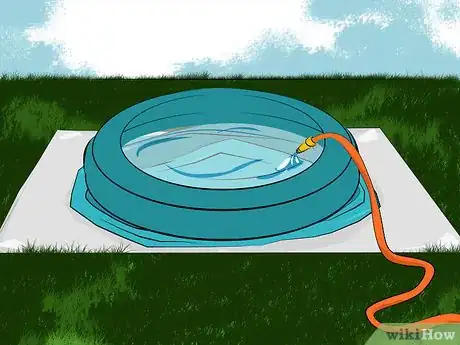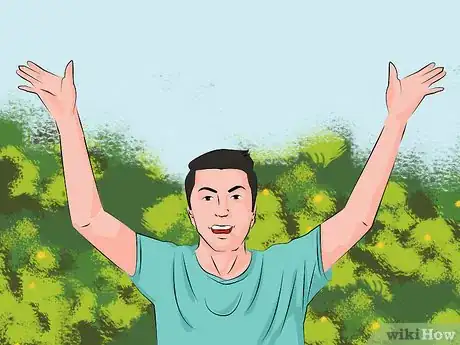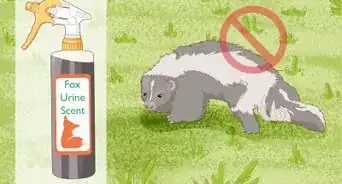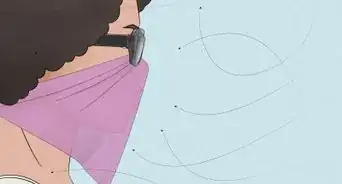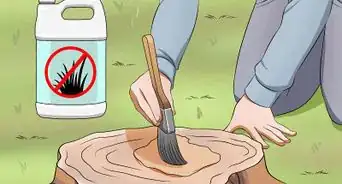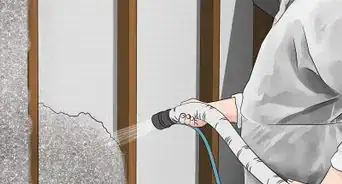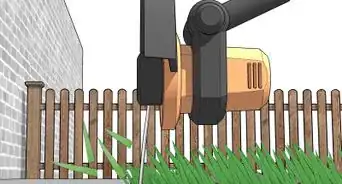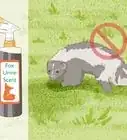This article was co-authored by Andrew Carberry, MPH. Andrew Carberry is a Food Systems Expert and the Senior Program Associate at the Wallace Centere at Winrock International in Little Rock, Arkansas. He has worked in food systems since 2008 and has experience working on farm-to-school projects, food safety programs, and working with local and state coalitions in Arkansas. He is a graduate of the College of William and Mary and holds a Masters degree in public health and nutrition from the University of Tennessee.
This article has been viewed 156,894 times.
While there are many benefits to lake weeds and algae, extreme proliferation can cause many problems. When lake weeds cover more than 25% of the lake surface it is considered dense growth. This can interfere with water recreation, such as boating and swimming. It can also interfere with fishing by producing a foul taste and smell in the water. Most importantly, dense lake weed growth can cause major fish kills by depleting oxygen in the water at night. Make sure to take the proper control measures in your lake or pond to ensure a safe and flourishing aquatic environment. Remember, aquatic vegetation is an important part of the ecosystem. If algae and underwater vegetation have taken over your pond or lake, use controls to restore balance without removing all of your vegetation.
Steps
Taking Preventative Measures
-
1Design your lake properly. Many species of lake weeds flourish when they can take root in underlying soil. You can prevent this by creating steep banks on the edge of your lake or pond, that descend directly into deep waters.
- Consider constructing lake banks with a 3:1 grade that descend into a water depth of 5ft. This strategy will prevent submersed plants from rooting in the lake, but it will not help with algae or free floating plants.
-
2Keep your lake deep. Make sure that your lake maintains a depth of 2-3ft at its most shallow point.[1] This will help prevent weeds from taking root if they continue to proliferate throughout your lake or pond. Keep in mind that this will only work for rooted weeds, not algae or free-floating plants.Advertisement
-
3Create a buffer zone around your lake. Lake weed proliferation is usually caused by an overabundance of nutrients in the surrounding soil. The runoff from fertilizer in the soil feeds these lake weeds and causes them to grow in large numbers. Create a riparian buffer zone by planting 100ft of natural plants or trees between your fertilized land and your lake to prevent runoff from entering the lake. Choose plants that will prevent erosion and that do not require any chemicals to be applied.
- If you have livestock, nutrients from their feed and animal waste may also enter runoff and cause weed proliferation. Consider building a fence around your livestock or keep them at least 100ft away from the lake's edge.
-
4Be proactive. Once you notice a significant lake weed issue, be sure to address it as soon as possible. Continual overgrowth will lead to more serious weed problems. The more you allow the weeds to grow, the more expensive and time-consuming it will be to address the problem at a later date.
- If you notice too many ducks or feeding fish around your lake, you may want to take steps to reduce their presence. Their waste can contribute to the growth of weeds.
Implementing Manual Controls
-
1Use a benthic barrier. A benthic Barrier is a sheet that lays on the bottom of the lake preventing sun from reaching the lake bottom so it kills lake weeds it targets. This is a non chemical reusable product that is safe for fish.
- Some vegetative growth is necessary for the health of the lake. If you use a benthic barrier, leave some area uncovered to allow for natural vegetative growth.
- Don't cover fish spawning or bird nesting areas.
-
2Remove weeds by hand. You can easily cut up lake weeds from the roots, collect the cut weeds, and remove them from your lake or pond. They can be cut with a sickle or pulled up by hand, then removed from the water with rakes or hoes.
- Most lake weeds are perennials, meaning they will continue to sprout throughout the season due to underwater roots. You must remove them from their underlying roots in order to be properly control them. [2]
-
3Use weed removal devices. Depending on the size of your lake or pond, and the weeds you are trying to remove, you may need an underwater or motor-driven device. Controlling lake weeds by hand can be labor intensive and difficult, as these weeds usually grow back quickly.
- Motor-driven underwater removal devices can help cut lake weeds loose under water, like water lilies and water milfoil. [3] There are also aquatic weed harvesters that collect weeds for removal. Motor-driven devices often leave cut-up weed fragments in the water. New weeds may grow from these pieces so be careful when removing weeds this way. [4]
- For surface algae in smaller bodies of water, water pumps can circulate the top layer of water to prevent algal scum from settling.
- Mechanical control of lake weeds can be likened to mowing a lawn. These devices will trim the weeds, but it is a temporary solution. [5]
-
4Dredge and deepen the lake. If the weed problem is severe, and weeds cover over 25% of the lake surface, consider dredging and deepening the lake. This will remove existing weeds and the bottom layer of sediment, as well as any underlying nutrients that cause weed proliferation. Dredging and deepening will reveal a layer of nutrient-poor soil, limit the amount of sunlight weeds are exposed to, and make it more difficult for weeds to take root.
Utilizing Proper Chemical Methods
-
1Choose the correct herbicide. It is necessary to properly identify the weed before purchasing herbicide. Different species and types require different herbicides. If you are unsure of the weed, call your county extension office or an herbicide dealer to make sure you buy the effective herbicide. [6]
- Make sure you understand the effects and implications of applying an herbicide before doing so. Read the label on your herbicide to understand the restrictions and wait time on boating, swimming, and fishing before applying. This may be an important factor when choosing an herbicide. [7]
- Herbicide comes in both liquid and solid form, as sprays or granules.
- For algal weed control, consider using copper sulfates or copper chelates, such as Cutrine Plus. These can be applied directly to the infested area as per the instructions on the label. [8] For certain submersed plants, such as pond weeds, and free-floating plants, such as duckweed, consider using a diquat or fluridone. Rooted-floating plants, such as water-lilies, and emergent plants, such as cattails, are best treated with glyphosate. [9]
- Check your local and state regulations before using herbicides in a body of water. Permits are required for some types of applications.
-
2Apply under the proper conditions. Herbicides are best applied in late spring when plants are youngest and weakest. If you wait until late summer when vegetation is thick, you risk major fish kills by depleting oxygen all at once. [10]
- Apply when water temperatures are in the upper 60s (Fahrenheit). Herbicides do not work effectively when the water is too cold. [11]
-
3Dose properly. Make sure that you are using the proper dose when applying herbicide. The herbicide label will describe how to calculate dosage. Dosage is usually measured based on acre-feet, which can be determined by multiplying the surface area acreage by the average depth. The label will then tell you how much to apply based on this measurement. [12]
- Never apply a larger dose than listed on the label. [13]
-
4Reapply as needed. Herbicides will need to be reapplied in subsequent years to come. Underlying seeds are unaffected by herbicides and will therefore emerge the next year despite initial treatment. Make sure to continue to apply in the spring to treat any structures that lay dormant in the winter. [14]
Using Biological Controls
-
1Check your local laws. Depending on the type of biological control that you use, you may need to get a permit from your local department of wildlife or agriculture. Some species that can control lake weeds are considered invasive in particular areas, and you may not be allowed to introduce them. Always learn what your local laws are before introducing a new animal or fish into your lake.[15]
-
2Introduce swans to the lake. Mute swans can be released onto small lakes. As they feed on both submerged plants and algae, they may be ideal to control vegetation. Keep in mind that swans require extra care, husbandry, and protection from predators.[16]
-
3Release grass carp into the lake. Also known as the white amur, grass carp feed on the submersed plants in your lake. They are usually introduced into a lake to control vegetation. Keep in mind that grass carp will eat almost any submerged vegetation, not just invasive species or weeds.
- Grass carp will not help much with duckweed or watermeal.
- It is recommended that you stock 15 to 30 fish per acre of lake. Get carp that are at least ten or twelve inches long.[17]
- Grass carp can be invasive. Check your local laws to make sure that you are allowed to use them as a biological control before you release them into your lake.
-
4Research which insects may be helpful. If you want to target a specific weed, you may look into using insects as form of biological control. You will need to find insects that are host-specific; this means you pick a species of insects that will only eat the specific weed that you want to remove. You can research your particular weed to see if there is an insect species that may help. You might also reach out to your local department of wildlife or agriculture, Noxious Weed Control Board, or an ecologist.
- Do not release non-native insects until you have verified that they will only eat the plant in question and that they will have no other impact on your local ecosystem.
Expert Q&A
Did you know you can get expert answers for this article?
Unlock expert answers by supporting wikiHow
-
QuestionHow do I kill a water plant without harming the fish?
 Andrew Carberry, MPHAndrew Carberry is a Food Systems Expert and the Senior Program Associate at the Wallace Centere at Winrock International in Little Rock, Arkansas. He has worked in food systems since 2008 and has experience working on farm-to-school projects, food safety programs, and working with local and state coalitions in Arkansas. He is a graduate of the College of William and Mary and holds a Masters degree in public health and nutrition from the University of Tennessee.
Andrew Carberry, MPHAndrew Carberry is a Food Systems Expert and the Senior Program Associate at the Wallace Centere at Winrock International in Little Rock, Arkansas. He has worked in food systems since 2008 and has experience working on farm-to-school projects, food safety programs, and working with local and state coalitions in Arkansas. He is a graduate of the College of William and Mary and holds a Masters degree in public health and nutrition from the University of Tennessee.
Food Systems Expert
-
QuestionWhich herbicides will kill water weeds without killing the fish in the lake?
 Andrew Carberry, MPHAndrew Carberry is a Food Systems Expert and the Senior Program Associate at the Wallace Centere at Winrock International in Little Rock, Arkansas. He has worked in food systems since 2008 and has experience working on farm-to-school projects, food safety programs, and working with local and state coalitions in Arkansas. He is a graduate of the College of William and Mary and holds a Masters degree in public health and nutrition from the University of Tennessee.
Andrew Carberry, MPHAndrew Carberry is a Food Systems Expert and the Senior Program Associate at the Wallace Centere at Winrock International in Little Rock, Arkansas. He has worked in food systems since 2008 and has experience working on farm-to-school projects, food safety programs, and working with local and state coalitions in Arkansas. He is a graduate of the College of William and Mary and holds a Masters degree in public health and nutrition from the University of Tennessee.
Food Systems Expert
-
QuestionIs it possible to use lake weeds in my perennial garden as fertilizer?
 Cheryl MorrisCommunity AnswerIf you compost it first. If any plants can grow on land as well, make sure it is a hot compost to kill the plants & seeds.
Cheryl MorrisCommunity AnswerIf you compost it first. If any plants can grow on land as well, make sure it is a hot compost to kill the plants & seeds.
References
- ↑ http://www.uky.edu/Ag/PAT/cat5/cat5.htm
- ↑ https://www.extension.purdue.edu/extmedia/apm/apm_3_w.pdf
- ↑ http://www.uky.edu/Ag/PAT/cat5/cat5.htm
- ↑ http://www.uky.edu/Ag/PAT/cat5/cat5.htm
- ↑ https://www.extension.purdue.edu/extmedia/apm/apm_3_w.pdf
- ↑ https://www.extension.purdue.edu/extmedia/apm/apm_3_w.pdf
- ↑ http://www.uky.edu/Ag/PAT/cat5/cat5.htm
- ↑ https://www.extension.purdue.edu/extmedia/apm/apm_3_w.pdf
- ↑ https://www.extension.purdue.edu/extmedia/apm/apm_3_w.pdf
- ↑ http://www.uky.edu/Ag/PAT/cat5/cat5.htm
- ↑ https://www.extension.purdue.edu/extmedia/apm/apm_3_w.pdf
- ↑ http://www.uky.edu/Ag/PAT/cat5/cat5.htm
- ↑ https://www.extension.purdue.edu/extmedia/apm/apm_3_w.pdf
- ↑ https://www.extension.purdue.edu/extmedia/apm/apm_3_w.pdf
- ↑ https://www.extension.purdue.edu/extmedia/apm/apm_3_w.pdf
- ↑ http://www.columbia.edu/itc/cerc/danoff-burg/invasion_bio/inv_spp_summ/Cygnus_olor.html
- ↑ https://www.extension.purdue.edu/extmedia/apm/apm_3_w.pdf
About This Article
To kill lake weeds, try laying a benthic barrier on the bottom of the lake. A benthic barrier is a sheet that prevents sunlight from reaching the bottom and kills any weeds there. If you use a benthic barrier, leave some areas uncovered to help underwater plants grow. Alternatively, use a motor-driven underwater removal device, which cuts back the weeds like a lawn mower. However, keep in mind that this doesn’t prevent weeds from growing back. You can also use an herbicide to kill the lake weeds. For algae, consider using copper sulfates or copper chelates. For pond weeds and free-floating plants, like duckweed, use a diquat or fluridone. It’s best to apply an herbicide in late spring when plants are youngest and weakest. However, keep in mind that herbicides can potentially be dangerous to fish and other wildlife. For more tips from our Natural Science co-author, including how to introduce swans to a lake to kill weeds, read on!
